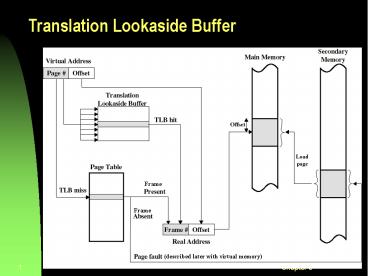Translation Lookaside Buffer - PowerPoint PPT Presentation
Title:
Translation Lookaside Buffer
Description:
Page Tables and Virtual Memory Page tables can be very large (32 ... Natural unit for protection purposes No internal fragmentation Disadvantage: ... – PowerPoint PPT presentation
Number of Views:395
Avg rating:3.0/5.0
Title: Translation Lookaside Buffer
1
Translation Lookaside Buffer
Frame
Frame
(described later with virtual memory)
2
Page Tables and Virtual Memory
- Page tables can be very large
- (32 - 64 bit logical addresses today)
- If (only) 32 bits are used (4GB) with 12 bit
offset (4KB pages), a page table may have 220
(1M) entries. Every entry will be at least
several bytes. - The entire page table can take up a lot of main
memory. - We may have to use a 2-level (or more) structure
for the page table itself.
3
Multilevel Page Tables
- With a 2 level page table (386, Pentium), the
page number is split into two numbers p1 and p2 - p1 indexes the outer page table (directory) in
main memory whose entries point to a page
containing page table entries for some range of
virtual memory - The second level entry is indexed by p2.
- Except for the directory (outer table), page
tables entries can be swapped in and out as needed
4
Inverted Page Table
One entry per FRAME rather than one per
PAGE Search for matching page
5
Sharing Pages
- Several users can share one copy of the same
program - Shared code must be reentrant (non
self-modifying) so that more than one process can
execute the same code - With paging, each process will have a page table
with entries pointing to the same code frames - only one copy of each page is actually in a frame
in main memory - Each user also needs to have its own private data
pages
6
Sharing Pages a Text Editor
7
Segmentation
- Processes actually consist of logical parts
(segments), such as - one or more executable segments
- one or more data segments
- stack segment
- Another idea make allocation more flexible by
loading segments independently.
8
Segmentation
- Divide each program into unequal size blocks
called segments - When a process is loaded into main memory, its
individual segments can be located anywhere - The methods for allocating memory to segments are
those we have seen so far just replace process
by segment - Because segments are of unequal size, this is
similar to dynamic partitioning (at the segment
level).
9
Logical address used in simple segmentation with
dynamic partitioning
- We need a segment table for each process,
containing - the starting physical address of that segment.
- the length of that segment (for protection)
- A CPU register holds the starting address of the
the segment table - Given a logical address (segment, offset)
(s,d), we access the sth entry in the segment
table to get base physical address k and the
length l of that segment - The physical address is obtained by adding d to k
- the hardware also compares the offset d with the
length l to determine if the address is valid
10
Address Translation in Segmentation(See also
Figure 9.18)
Disp d
11
Logical-to-Physical Address Translation in
Segmentation
displacement
12
Sharing in Segmentation Systems
- The segment tables of 2 different processes can
point to the same physical locations - Example one shared copy of the the code segment
for the text editor - Each user still needs its own private data
segment - more logical than sharing pages
13
Segment Sharing Text Editor Example
14
Evaluation of Simple Segmentation
- Advantage memory allocation unit is a logically
natural view of program - Segments can be loaded individually on demand
(dynamic linking). - Natural unit for protection purposes
- No internal fragmentation
- Disadvantage same problems as dynamic
partitioning. - External fragmentation
- Unlike paging, it is not transparent to
programmer - No simple relationship between logical and
physical address
15
Combined Segmentation and Paging
- Combines advantages of both
- Several combinations exist. Example
- Each process has
- one segment table
- one page table per segment
- Virtual address consists of
- segment number index the segment table to get
starting address of the page table for that
segment - page number index that page table to obtain the
physical frame number - offset to locate the word within the frame
- Segment and page tables can themselves be paged
16
Address Translation in Combined
Segmentation/Paging System(see also Fig 9.21)
17
Advantages of Segmentation Paging
- Solves problems of both loading and linking.
- Linking a new segment amounts to adding a new
entry to a segment table - Segments can grow without having to be moved in
physical memory (just map more pages!) - Protection and sharing can be done at the
logical segment level.































